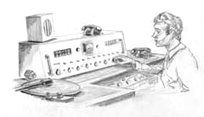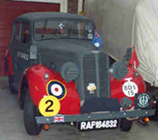|
 |
 |
 |
 |
 |
 |
 |
 |
 |
 |
 |
 |
 |
 |

Dept. Electra House - Gawcott Radio Station
|
 |
 |
 |
|
|
|
|
|
|
|
|
|
|
 |
 |
|
In order to transmit the propaganda programmes, which were being recorded onto discs, Harold Robin, head of the technical operations, in early 1940 was tasked to find a suitable site to build a radio station. Surveying the immediate area, he eventually chose a large field at Gawcott, near Buckingham and construction duly began. The radio station at Gawcott was approached by a gravel path and - topped by an electrified strand - a four foot high barbed wire fence surrounded the site.With Russell Coleman as his 2nd in command, Mr. Thomas Pryke held charge of the station with the personnel accommodated at lodgings in the village. Initially one transmitter, an American R.C.A., was accommodated at the site, housed in a wooden builing. Then in December, 1941, the purchase of a second, identical transmitter was |
|
 |
|
Radio Operators Console. The discs were played on the turntable to the left, with the arm tracking from the centre towards the outside edge.
|
|
|
 |
sanctioned by the Treasury with Gambier Parry tasked to send off a cable to the United States immediately. By December 24th.
The project, FT4, had the utmost urgency:- A/C priority for the manufacture of a 4750, 71/2kw RAC Transmitter for delivery from America in April. When this arrived it was housed in a brick building, some 350 yards from the wooden counterpart and midway lay a small, brick structure, where the incoming telephone lines terminated This also served as an office for Lieutenant Hal Fuller, who also had responsibility for the radio station at Potsgrove. Whenever he went on leave, Second Lieutenant Ainsley assumed command. In time, they would be promoted to Captain and Lieutenant respectively. Near to each transmitter was a brick built powerhouse, each containing a diesel powered generator. One was a large, single cylinder Rushton with an eight foot diameter flywheel and after use this needed to be set in a certain position with a crowbar, ready for starting with compressed air from a steel pressure vessel, supplied by a small, petrol driven compressor. The other generator was powered by a Crossley diesel, again started by air in a similar system. Both machines were water cooled.
|
|
|
|
|
|
|
 |
|
|
 |
|
|
|
 |
|
Hillman Minx saloons, painted black, were extensively used to transport the discs to the transmitters and to ferry the various Research Units to and from the recording centre. The Hillman Minx illustrated in the colours of the Bomb Disposal Unit.
|
|
|
 |
Click here to see a video interview of the owner of this vehicle, restored to bomb disposal condition. |
|
|
|
 |
A three man crew tended the maintenance of both the diesels, lead by Bill Heatley. The transmitter in the wooden hall went by the name of Geranium, which had two turntables and the brick one by the name of Gardenia. Both buildings were surrounded by brick built blast walls. The buildings were entered through a sliding door, which gave access to a cloakroom/locker room. Another sliding door then gained access to the operations room, wherein stood a desk complete with a control console and two record player turntables. Facing this was the front panel of the R.C.A. 10KW air cooled transmitter. On one side of the control room was a kitchen and toilets and on the other side a workshop, equipped with hand tools and a bed, folded into the wall, to be used in emergencies, such as the station being cut off by snowdrifts. The final room housed a large, oil cooled transformer where an incoming high voltage electricity supply was converted to 220V and then dropped -by an autotransformer -to 110V, this being standard for American equipment. The shifts at the station ran from 1700-2300 and 2300-0800, in addition to the daytime shifts with two days off per fortnight. As for the personnel, they were a mix of permanent civilian Post Office employees, R.A.F. secondment and SCU1. Warrant Officer 'Tommy' Pryke ran the station assisted by his deputy, Staff Sergeant Russell Coleman. Made at Milton Bryan and 'Simpsons', (Wavendon Towers), twice a day a large consignment of glass-based discs were delivered to the station by civilian drivers, in black saloons. |
|
|
|
 |
|
|
|
|
|
Back to top |
|
|
|
|
|
|
|


